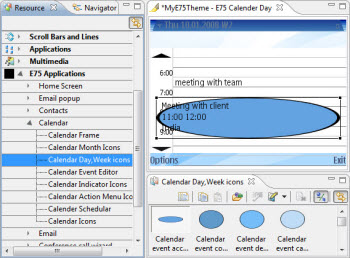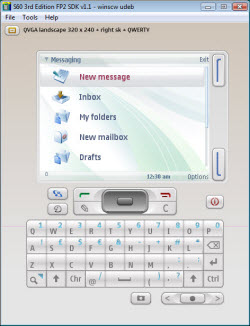New Eseries tools
The Nokia E75 plug-in for Carbide.ui makes available a number of Eseries and Nokia E75 specific resources to theme developers. There were already two Eseries specific plug-ins for Carbide.ui, for the Nokia E66 and Nokia E71. All three plug-ins add resources for Eseries specific applications, highlights, and icons to Carbide.ui. The Nokia E75 plug-in also adds Conference Call Wizard and Internet Browser applications resources, along with a number of additional application icons.

One disappointment is that these new theme elements are not available to preview within Carbide.ui, meaning ownership of a Nokia E75 is pretty much essential to make theme testing practical.
The Nokia E75 (and two earlier) plug-ins are delivered as zip files. They are added to Carbide.ui using the Plug-ins Management option in Preferences (use Windows > Preferences to access). Once installed, the additional theme elements can be activated by selecting Nokia E75 from the platforms selector drop down.
The second tool released in support of the Nokia E75 is the Eseries SDK Plug-in for the S60 3rd Edition, Feature Pack 2 SDK. This plug-in brings the APIs for the printing framework, email LED, and Nokia Eseries device identification to the feature pack 2 SDK. The latter two APIs are unchanged from their feature pack 1 versions, but the printing framework now offers an Application Interworking (AIW) interface, which should make adding printing features to applications more straightforward.
The plug-in also adds a 320 x 240 pixel skin with QWERTY keyboard to the emulator, which should make the testing of applications for the Nokia E75 more intuitive.

From the stats department
The survey alluded to in the introduction was undertaken by Skyhook Wireless. Released under the headline ‘Less than 10% of LBS Developers Will Port Apps to Palm & Symbian’ it received some coverage during the week, notably from PC Magazine and Information Week.
The problem with this survey, or more accurately the way it was reported, is the lack of context to this information. The fact that most interest appears to be in porting to iPhone and Android could be due to the responding developers already having applications for Windows Mobile, Java, or Symbian and therefore wanting to port to get maximum market coverage.
On the other hand, if the pool of 100 developers who responded to the survey were US based the results could reflect alower level of awareness amongst US based developers for Symbian OS.
The results could reflect equally a genuine lack of interest in developing for Symbian OS.
Overall, however, the result reflects the developer relations challenge facing Symbian, which is exacerbated by the fragmented approach to application sales. While Apple is already building the PR bandwagon around its billionth application download, we still have no idea what volume of Symbian applications are being shipped. Talking to many long standing Symbian developers, who have expanded into Windows Mobile or iPhone development, Symbian remains their most lucrative and build first platform. This message is clearly not getting through to non-Symbian developers.
Regrettably history tells us that there is no guarantee that the most technically suitable solution will become the most prevalent. Against the weight of the Apple and Google PR machines, is this what we are seeing with Symbian?
